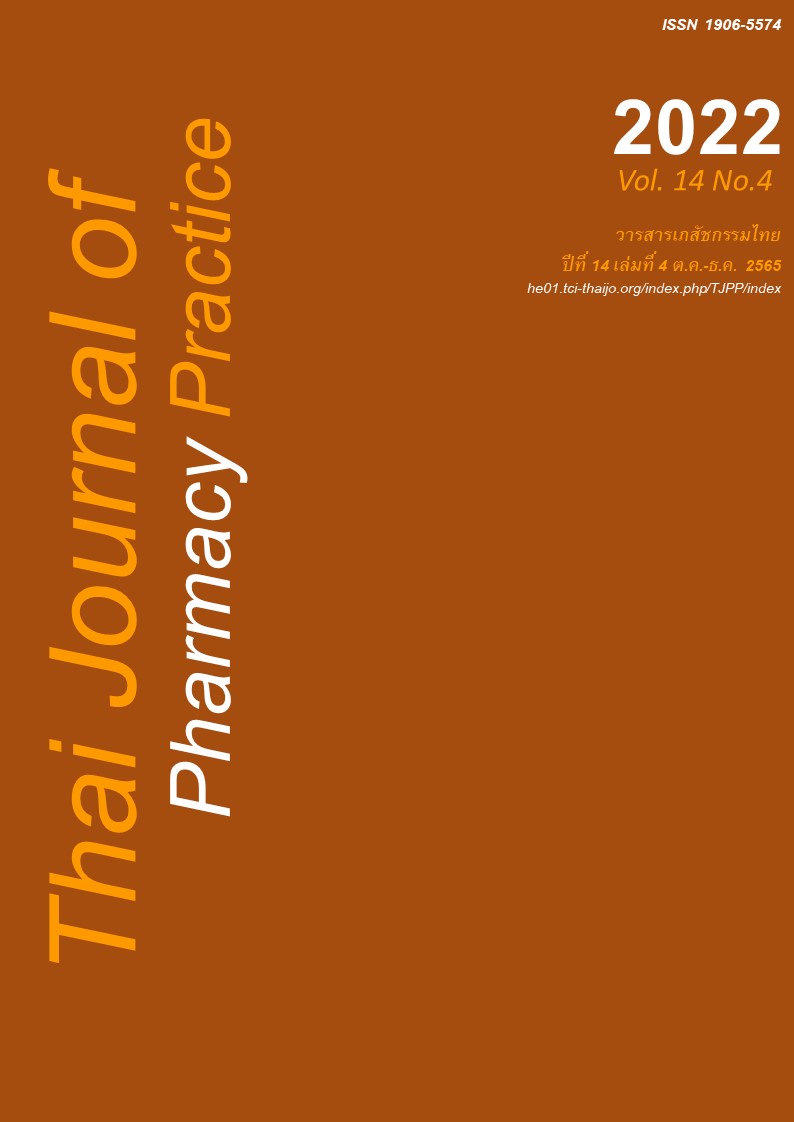ผลของการให้บริบาลทางเภสัชกรรมแก่ผู้ป่วยที่บ้านต่อการจัดการปัญหาเกี่ยวกับยา ในผู้ป่วยเบาหวานที่ใช้ยาฉีดอินซูลินชนิดปากกาในอำเภอเขาฉกรรจ์ จังหวัดสระแก้ว
Main Article Content
บทคัดย่อ
วัตถุประสงค์: เพื่อประเมินผลของการให้การบริบาลทางเภสัชกรรมแก่ผู้ป่วยที่บ้านต่อการจัดการปัญหาเกี่ยวกับยา ความรู้และทักษะในการใช้อินซูลินชนิดปากกาของผู้ป่วยหรือผู้ดูแล และผลการรักษาทางคลินิก วิธีการ: การวิจัยนี้เป็นการศึกษาแบบกลุ่มเดียวที่วัดผลก่อนและหลังการให้บริบาลทางเภสัชกรรมอย่างน้อย 3 เดือนแก่ผู้ป่วยที่บ้านทั้งหมดที่ได้รับยาฉีดอินซูลินชนิดปากกาที่มีค่า HbA1c>7 mg% หรือเข้ารับการรักษาด้วยภาวะน้ำตาลในเลือดสูงหรือต่ำ ที่แผนกฉุกเฉินของโรงพยาบาลเขาฉกรรจ์ การศึกษารวบรวมและประเมินข้อมูลจากการประเมิน INHOMESSS และการจัดการปัญหาเกี่ยวกับยาตามแนวทางของ Pharmaceutical Care Network Europe (PCNE) ผลการวิจัย: ผู้ป่วยเข้าร่วมการศึกษาจำนวน 31 คน มีอายุเฉลี่ย 62.65±12.22 ปี จากการประเมิน INHOMESSS พบปัญหาด้านยาในผู้ป่วยทุกราย รองลงมาคือด้านโภชนาการ (ร้อยละ 80.65) จากการประเมินด้วย PCNE พบปัญหาเกี่ยวกับการใช้ยา 99 ครั้ง เป็นปัญหาด้านประสิทธิภาพการรักษามากที่สุด (ร้อยละ 82.82) การประเมินระบุสาเหตุของปัญหาที่พบได้ 190 ครั้ง สาเหตุที่พบมากที่สุดจากตัวผู้ป่วยเอง (ร้อยละ 52.11) ในวิธีการแก้ไขปัญหาที่ใช้ 246 ครั้ง ส่วนใหญ่แก้ไขที่ผู้ป่วยหรือผู้ดูแล (ร้อยละ 63.82) การประเมินหลังการให้การบริบาลทางเภสัชกรรมแก่ผู้ป่วยที่บ้าน พบว่า ปัญหาร้อยละ 58.59 ได้รับการแก้ไขได้ทั้งหมด อีกร้อยละ 35.35 แก้ไขได้บางส่วน ความรู้ในการใช้ยาฉีดอินซูลินมีคะแนนเพิ่มขึ้นจาก 4.81±2.07 เป็น 7.77±2.17 จากคะแนนเต็ม 10 (P<0.001) ด้านทักษะการใช้ยาฉีดอินซูลิน มีคะแนนเพิ่มขึ้นจาก 14.42±3.16 เป็น 16.77±2.32 จากคะแนนเต็ม 20 (P<0.001) ระดับน้ำตาลในเลือดหลังอดอาหารลดลงจาก 207.16±66.62 mg/dl เป็น 162.19±39.27 mg/dl (P=0.001) และค่า HbA1c ลดลงจาก 9.29±1.91 mg% เป็น 7.82±1.96 mg% (P<0.001) สรุป: การให้การบริบาลทางเภสัชกรรมที่บ้านในผู้ป่วยที่ใช้ยาฉีดอินซูลินชนิดปากกา สามารถแก้ปัญหาเกี่ยวกับการใช้ยาได้ โดยผู้ป่วยมีความรู้และทักษะของการใช้อินซูลินชนิดปากกาเพิ่มขึ้น สอดคล้องกับผลการรักษาทางคลินิกที่พบค่าระดับน้ำตาลในเลือดหลังอดอาหารและ HbA1c ที่ลดลง
Article Details

อนุญาตภายใต้เงื่อนไข Creative Commons Attribution-NonCommercial-NoDerivatives 4.0 International License.
ผลการวิจัยและความคิดเห็นที่ปรากฏในบทความถือเป็นความคิดเห็นและอยู่ในความรับผิดชอบของผู้นิพนธ์ มิใช่ความเห็นหรือความรับผิดชอบของกองบรรณาธิการ หรือคณะเภสัชศาสตร์ มหาวิทยาลัยสงขลานครินทร์ ทั้งนี้ไม่รวมความผิดพลาดอันเกิดจากการพิมพ์ บทความที่ได้รับการเผยแพร่โดยวารสารเภสัชกรรมไทยถือเป็นสิทธิ์ของวารสารฯ
เอกสารอ้างอิง
International Diabetes Federation. IDF diabetes atlas [online]. 2021 [cited Jul 8, 2022]. Available from: www.diabetesatlas.org/.
Diabetes Association of Thailand. Diabetes clinical practice guideline [online]. 2017 [cited Feb 6, 2019]. Available from: www.dmthai.org/attachments/article/ 443/guideline-diabetes-care-2017.pdf
Health Information System Development Office. Thai health stat [online]. 2020 [cited Jul 10, 2022]. Available from www.hiso.or.th/thaihealthstat/.
American Diabetes Association. Standards of medical care in diabetes. Diabetes care 2020; 43 (suppl 1): P1-224.
Doggrell SA, Chan V. Adherence to insulin treatment in diabetes: can it be improved? J Diabetes. 2015; 7: 315-21.
Michael R. Insulin pens: improving adherence and reducing costs [online]. 2015 [cited Feb 07, 2021]. Available from: www.pharmacytimes.com.
Lasalvia P, Barahona-Correa JE, Romero-Alvernia DM, Gil-Tamayo S, Castañeda-Cardona C, Bayona JG, et al. Pen devices for insulin self-administration compared with needle and vial: systematic review of the literature and meta-analysis. J Diabetes Sci Technol 2016; 10: 959-66.
Jittsue A, Sangjam P, Treesak C, Hanlerdrit T. Assessment of knowledge and practice of patients before and after counseling in the use of the reusable insulin pen at Vachiraphuket Hospital. Songklanagarind Medical Journal. 2016; 34: 27-37
Forough AS, Esfahani PR. Impact of pharmacist Intervention on appropriate Insulin pen use in older patients with type 2 diabetes mellitus in a rural area in Iran. J Res Pharm Pract 2017; 6: 114-9.
Pharmacy Department, Lam Thap Hospital. Effect of pharmaceutical care in diabetic patients who treated with insulin injection. Krabi: Lam Thap Hospital; 2016.
Al Ajlouni M, Abujbara M, Batieha A, et al. Preva lence of lipohypertrophy and associated risk factors in insulin-treated patients with type 2 diabetes mellitus. Int J Endocrinol Metab. 2015; 13: e20776.
Promchaisri K, Lerkiatbundit S, Saengcharoen W. Effect of self-efficacy enhancing program on ability to use insulin-penfill injection among patients with diabetes type 2: A randomized controlled Trial. Thai Journal of Pharmacy Practice. 2019; 11: 648-58
Thomudtha P, Pattanajak C, Thomudtha A, Khampa S, Phoomwanitchakit S, Jeeraaumponwat P, et al. Effects of home care pharmacy service in urban area health system, Mahasarakham Province. Srinaga rind Medical Journal 2017; 32: 229-35.
Schampati S. Causes of patient’s medication problems and interventions in home care visits by pharmacists. Thai Journal of Clinical Pharmacy 2017 ; 23(2): 1-9.
Rachaniyom S, Saramunee K. Family pharmacist’s management of drug related problems for chronic diseases at patient’s in home, Kranuan District Health Network. Thai Journal of Pharmacy Practice. 2016; 8: 169-81.
Debavalya U, Moolasarn S, Orossarum J, Samang sri K, Yenwijitsopa A, Jaipen P. The impacts of home care pharmacy services in diabetic patients. Thai Journal of Hospital Pharmacy. 2008; 18: 39-51.
Pharmaceutical Care Network Europe Foundation. PCNE classification for drug related problems V 8.02 [online]. 2017 [cited Feb 10, 2021]. Available from: www.pcne.org/upload/files/230_PCNE_classification_V8-02.pdf.
Wright BM, Bellone JM, McCoy EK. A review of insulin pen devices and use in the elderly diabetic population. Clin Med Insights Endocrinol Diabetes. 2010; 3: 53-63.
Thumthaew N, Promasatayaprot V, Chumnanbori rak P. The development of health care for patient diabetes types 2 in the area responsibility of health Khon Paen Health Promoting Buntharik District Ubonratchthani Province. Academic Journal of Community Public Health. 2021; 7: 32-44.
Maneephan P, Rookkapan K. Drug related problems in patients hospitalized to a community hospital within three border southern provinces and management of the problems by pharmacist. Thai Journal of Pharmacy Practice. 2018; 10: 551-62.
Manatphaiboon S, Maitreemit P, Oo-puthinan S. Effect of pharmaceutical care with empowerment in type 2 diabetic patients at Mettapracharak (Watrai khing) Hospital. Isan Journal of Pharmaceutical Sciences. 2017; 13: 37-51.
Bahendeka S, Kaushik R, Swai AB, Otieno F, Bajaj S, Kalra S, et al. EADSG guidelines insulin storage and optimisation of injection technique in diabetes management. Diabetes Ther 2019; 10: 341–66.


